|
 Secure Site
Secure Site
|
 |
 Sleepiness Might Be in the Genes No matter how little they sleep, some people can keep a skip in their step while others will yawn and struggle through the day. A new study from the University of Pennsylvania School of Medicine found that the reason could be in our genes.
Researchers found that healthy people with one particular genetic variant were generally sleepier than those without the gene. About 25 percent of the general public has the genetic variant, called DQB1 *0602, but only a small percentage of them actually suffer from sleep problems.
One person who has been told by his doctor that he may have this genetic variation is Robert Gibson, a 43-year-old machine shop supervisor in Milan, Illinois. Sleep is supposed to rejuvenate the body, but for Gibson, it can be anything but invigorating.
 Sleepiness Might Be in the Genes It would not be the only gene-linked sleep condition Gibson experiences; he already suffers from bouts of sleep paralysis, a disorder in which sufferers feel paralyzed as they fall asleep or as they wake up. Episodes can last a few seconds to a couple of minutes, but Gibson said the effects of the temporary paralysis seem to bog him down all day.
“It feels like I am drugged down, like there’s a heavy weight on me the whole next day,” said Gibson.
Gibson’s sleep problems are more than just the garden-variety; years ago, doctor’s did find a genetic biomarker that may have to do with his sleep disorders, and, because many genes probably contribute to sleep habits, doctors say Gibson probably has DQB1 *0602 as well.
“He hasn’t been tested for this gene yet, but it could be part of the spectrum of genes that contribute to his sleep habits,” said Dr. Mark Dyken, a professor of neurology at University of Iowa College of Medicine who treated Gibson.
Genes and Heavy-Eyes
For the study, researchers compared healthy people with the gene variant to healthy people without it to see if they suffered from any other sleep-related problems.
The research, published in the journal Neurology, found that people with the gene variant reported feeling sleepier and more fatigued compared to the people without the variant, whether they slept four hours or 10 hours. People with the gene variant also spent less time in deep sleep, and woke up more times during their sleep compared to the non-gene participants.
“When the genetic variant people were fully rested, they still rated themselves sleepy,” said Dr. Namni Goel, lead author of the study and assistant professor of psychiatry at the University of Pennsylvania School of Medicine. “They had a lower drive to sleep when challenged by sleep loss, and overall they had a more fragmented sleep with more arousals in comparison to those who didn’t carry the gene. We found it very interesting that they were healthy people, but when challenged, they looked like narcoleptics.”
 Sleepiness Might Be in the Genes Could Some Sleepiness Be Genetic?
In the study, 92 healthy adults without the gene were compared to 37 healthy adults who had the gene but did not have a sleep disorder. Researchers tested each participants’ sleep quality and self-rated tiredness. They also tested memory, attention, and the ability to resist sleep during the day.
The participants spent seven days in the sleep laboratory. For the first two nights, everyone spent 10 hours in bed. For the following five nights, participants only spent four hours in bed per night. During waking hours, the lights were kept on, and they were allowed to play games, read, and watch movies. They were not allowed to consume foods and drinks that could affect their sleep, such as caffeine, turkey, bananas, or alcohol.
Despite the inconsistent sleep patterns throughout the seven-day trial, results for the memory and cognitive skills were similar in both groups.
The Role of Sleep
Dr. Mark Mahowald, medical director of the Minnesota Regional Sleep Disorders Center, said that the study results are important because people tend to make sweeping statements about sleep deprivation — when sleep is different for everyone because there are huge genetic components that contribute to our slumber.
“The medical profession has been guilty for decades ofsleep deprivation in its trainees, so they made recommendations of the number of hours someone should work, but they made across-the-board, sweeping recommendations,” said Mahowald. “The implication is that everyone is sleep-deprived and sleep-deprivation does the same thing to everyone, but the tolerance and range of sleep is so different for different people.”
“A one-size-fits-all policy is probably not a very wise idea when it comes to sleep,” said Mahowald. “Our society has equated sleepiness with defects of character, like laziness and depression, but really, some people are generally sleepier during the day. They’re more prone to naps, and to sleeping in. We have to accept the fact that sleep duration is genetically determined and not a sign of defect.”
No Rest for the Weary
So what’s a tired person to do? Not much, said doctors, but Dr. Goel said she hopes to continue her research with genetic biomarkers. She said they might help to predict a person’s response to sleep deprivation, especially for those who work a night shift, travel often through many time zones, or those who lose sleep due to personal or family obligations. At any rate, doctors said that tiredness is certainly a manageable condition.
“Down the line, if someone is carrying this gene, maybe they can employ a countermeasure,” said Goel. “Maybe they could have caffeine to counteract some of these symptoms.”
Boulder, Colorado—an innovative company has taken one of life’s most unpleasant experiences (being startled awake by your alarm clock early Monday morning), and transformed it into something to actually look forward to. “The Zen Alarm Clock,” uses soothing acoustic chimes that awaken users gently and gradually, making waking up a real pleasure. Rather than an artificial recorded sound played through a speaker, the Zen Clock features an alloy chime bar similar to a wind chime. When the clock’s alarm is triggered, its chime produces a long-resonating, beautiful acoustic tone reminiscent of a temple gong. Then, as the ring tone gradually fades away, the clock remains silent until it automatically strikes again three minutes later. The frequency of the chime strikes gradually increase over ten-minutes, eventually striking every five seconds, so they are guaranteed to wake up even the heaviest sleeper. This gentle, ten-minute “progressive awakening” leaves users feeling less groggy, and even helps with dream recall.
adapted from abcnews.go.com by Mikaela Conley
Now & Zen – The Chime Alarm Clock and Timer Shop
1638 Pearl Street
Boulder, CO 80302
(800) 779-6383
orders@now-zen.com
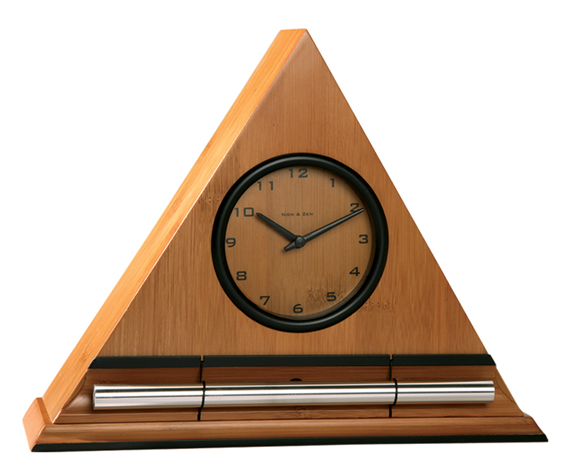 The Zen Alarm Clock for a Gradual Awakening
Posted in Bamboo Chime Clocks
 walking in waves, a mindfulness meditation There is nothing more soul-renewing than a very long, meandering, aimless walk. And I do mean aimless — as in, “I’m heading out! I have no idea how long I’ll be or where I’m going!”
I started walking this way quite by accident, in the midst of recovering from the heartache and confusion of losing my job. I had been slothful through winter, alternating between insomnia and sleeps so deep I wasn’t sure what day it was when I woke. But with the changing light of spring, I was beckoned out of doors.
Finding Peace Amidst the Chaos
I was in Manhattan, and cities are excellent places for meditative walks. They’re full of interruptions and distractions, but there is always a bus stop or a person with directions within easy distance. So you can suspend the anxiety about getting lost or getting home.
And all that noise does for humans what shape does for bats: Even if we aren’t tuning into it, it guides our steps and signals danger or direction.
A city walk also delivers the pleasure of unexpected architectural discoveries: trolls clinging to the corners of buildings, swags of flowers carved into stone friezes.
These days I’m walking in the country, in coastal Rhode Island, where the blackbirds and foxes keep me company.
“Exploring the world is one of the best ways of exploring the mind,” writes Rebecca Solnit in “Wanderlust: A History of Walking.” The mind eventually begins to follow the feet, and a logjam of anxiety starts to come loose.
 Soul-Renewing Walking Meditation From Type A to Point Be
Long walks are the cure for writer’s block, lover’s block, mother’s block, friendship block, and any other kind of obstacle that we try to deliberately gnaw our way through, worrying over the problem and getting nowhere.
Better to let yourself really go nowhere and experience the delicious paradox of losing yourself to find yourself.
Walking with indirection has, at heart, a paradoxical benefit. When you stop making decisions for a little while, before you know it, you are filled with purpose, and the goals and paths of your life take on a new clarity.
It is by such grace that life unfolds; how lovely to suspend disbelief (I will never feel good again) and arrive at conviction: Life is wonderful! What a joy to be moving!
How-To: Walking as Meditation
1. Focus on your breathing. Paul Smith, walking-meditation instructor at Lake Austin Spa Resort in Austin, Texas, recommends inhaling slowly through your nose for 4 steps, keeping your breath in for 2 steps, exhaling for 4 steps, then waiting 2 steps before inhaling again.
2. Gently corral your wandering mind. Try repeating an affirmation in time with your breathing and steps. Smith recommends phrases such as “My life is a pleasure,” “I speak the truth and listen without judging,” or “I see all things in clarity.” Another trick: Visualize putting your worrisome thoughts in a balloon and letting go of the string.
3. Hold one hand behind your back. This will help slow you down. “Don’t let yourself get into race-walking mode,” Smith says.
4. Pay attention to your senses. Focus on vision first, which is easiest. Notice a plane overhead, leaves in the trees. Then notice sounds around you, the sun on your face, the smell of cut grass. Smith says, “These are ways to stay in the present.”
5. On a practical note: If you’re walking for distance, carry a little “mad money” in case you tucker out miles away. But no cell phone — or turn it off if you must have it on you.
adapted from Wholeliving.com, September 2010 by Dominique Browning
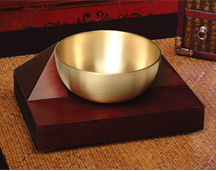 Singing Bowl Meditation Timer & Alarm Clock
Our Zen Timepiece’s – (a Singing Bowl Meditation Timer) acoustic 6-inch brass bowl-gong clock is the world’s ultimate alarm clock, practice timer, and “mindfulness bell.”
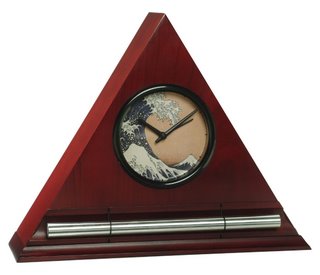 Hokusai Wave Zen Meditation Timer and Alarm Clock Now & Zen – The Meditation Timer Store
1638 Pearl Street
Boulder, CO 80302
(800) 779-6383
Posted in Chime Alarm Clocks, Hokusai Wave, intention, Japanese Inspired Zen Clocks, Meditation Timers, Meditation Tools, mindfulness practice, nature, Walking Meditation, Well-being, Zen Timers
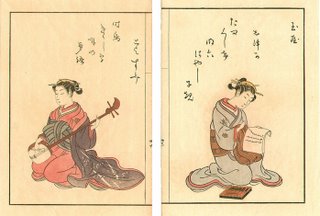 Shamisen and Letter by Harunobu 1. Spirituality
Experience your spirituality as a gift and a process.
2. Compliments
Don’t shrug off compliments; honor and remember them.
3. Experiences
Invest in experiences, not just objects.
4. Grace
Try doing even the most menial tasks mindfully and with grace.
5. Compassion
Anger has a way of evaporating in the face of compassion.
6. Calm
Calm is a place you create in the midst of chaos.
7. Simplicity
There’s no substitute for simple pleasures.
8. Laughter
Laugh a little — every day.
9. Physical
The spiritual and the physical cannot be separated; you need one to experience the other.
10. Pleasure
Find pleasure in the simplest tasks.
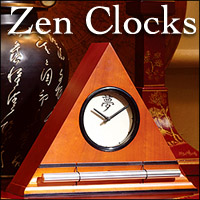 Zen Clocks with Chime from Boulder, CO adapted from Body + Soul Magazine, 2009
Now & Zen – The Zen Alarm Clock Shop
1638 Pearl Street
Boulder, CO 80302
(800) 779-6383
Posted in Meditation Timers, Meditation Tools, mindfulness practice, Well-being
 Insomnia Suggestions You’ve tried it all—chamomile tea, hot baths, aromatherapy, melatonin—and nothing works. Your insomnia obviously calls for something a little stronger than a glass of warm milk. In fact, you need something that packs a bit more punch, but you don’t want to resort to sleep medications. Good news: Sleep researcher Roger Cole, PhD, from Del Mar, California, recommends two powerful, natural sleep therapies that have helped many insomniacs drift off peacefully to dreamland.
Resetting your body clock
If you have difficulty falling asleep at night and waking up in the morning, try dawn/dusk simulation, a form of sleep therapy that resets your body clock. Your body uses natural signals, including sunlight and darkness, to trigger hormones that make you active in the morning and sleepy at night. Bright light, particularly morning sunlight, provides the strongest signal the body uses to regulate this hormonal cycle, called your circadian rhythm. So if you typically awaken before sunrise or work in artificially lit environments, your circadian rhythm may have gotten out of sync. Using a light box may help you reset it.
Here’s how to do it: Spend the first half hour of each morning in simulated “dawn,” by sitting in front of a light box. You can do this while you eat your breakfast, read the paper, or go about your morning routine. Before bed, spend time in simulated “dusk” by closing the curtains and keeping lights dim. This combination should reset your clock within a few days.
If sleep problems continue, wake up and use your light box a half hour earlier for a few days. Cole says eventually you’ll hit a “magic sleep spot.” Once you do, you should be able to discontinue the therapy. But people who are true night owls may need to keep using both dawn and dusk simulation indefinitely to stay on their new schedules.
Cole recommends a light box that delivers 10,000 lux at a distance of at least 20 inches. A large field of view (at least 18” wide) is a plus, and a box that gives white light with an extra boost of blue or blue-green may be more effective than a plain white box.
 sleepless nights call for solutions Sleep restriction
If you have trouble falling and staying asleep, and spend time tossing and turning, sleep restriction therapy may be the ticket. This therapy is based on the theory that although your body may have learned to get along without sleep, it’s actually possible for you to retrain it.
Start by estimating how much sleep you typically get each night, as opposed to how many hours you stay awake in bed hoping for sleep (say five hours of sleep for seven in bed). Stay in bed only for the amount of time you usually sleep (the five hours), scheduling your bedtime and wake-up time appropriately (say, 1 a.m. to 6 a.m.). Meanwhile, use your bedroom for sleeping only (and for, well, you know). And no fair taking mid-day naps.
If you do wake up during the night, lie awake in bed no more than 15 minutes. Then leave the bedroom, stay warm, and engage in a peaceful activity in a dimly lit room, returning to bed when you feel ready to sleep. And now—here’s the hard part—get up at your scheduled wake-up time (6 a.m., in our example), no matter what.
By the third or fourth night, you’ll be so exhausted that you’ll probably sleep through the night. Once you sleep well two or three nights in a row, increase your time in bed by 15 minutes—five hours and 15 minutes in our example. The extra minutes may cause some wakefulness again, so keep repeating your new schedule until you sleep soundly again for a couple of days. Then, you can add another 15 minutes, so you’re up to five hours and 30 minutes. Gradually work yourself up to seven hours of sleep (eight or nine may be unrealistic).
Obviously, sleep restriction requires self-discipline. But Cole reports that this therapy has been “experimentally proven to be as powerful as sleeping pills for helping insomniacs sleep, and is probably more powerful for the long term.” He does caution that sleep disorders can mask depression; if you notice other symptoms of depression, talk to your health practitioner before you try this therapy.
adapted from Natural Solutions Magazine, April 2006 by Nina Zolotow
 Gentle Awakening Alarm Clocks with Peaceful Chime Now & Zen – The Zen Alarm Clock Store
1638 Pearl Street
Boulder, CO 80302
(800) 779-6383
Posted in Chime Alarm Clocks, sleep, Sleep Habits
 Mantra Meditation: Utamaro Kitagawa, The Courtesan Hanaogi of Ogiya Mantra Meditation
What is it?
Mantra meditation utilizes the power of sound and vibration to create stillness in the body, calm the nervous system and ultimately transform the mind. The words typically come from ancient spiritual languages, such as Sanskrit or Gurumukhi. The sacred meanings of the words enable you to establish a connection to profound truths that have been spoken for thousands of years, explains Krishna Kaur, a kundalini yoga teacher since 1970 and founding member of the International Association of Black Yoga Teachers (blackyogateachers.com).
What’s it good for?
Because each mantra differs in its meaning and vibrations produced, you can select mantras to create specific effects— such as increasing mental clarity, developing intuition, or reducing anger and stress. Kaur suggests starting with the simple mantra sat nam because it’s easy to say and remember, yet offers profound effects. Sat translates as “truth,” and nam as “identity.” This mantra helps you identify with a universal spiritual truth in which such transient emotional states as fear, anger and doubt fall away.
How long does it take?
Start with three to five minutes, increasing by a minute at a time until you can sit and chant for a full 11 minutes.
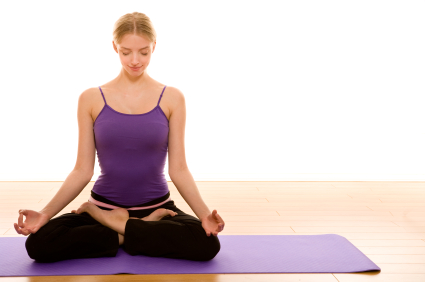 Meditation How do I do it?
1. Sit comfortably in a chair or on the floor with your spine straight to help your breath and the sound it creates flow smoothly. Close your eyes and bring your attention to your breath for a moment to get centered.
2. Take a long, deep inhalation through your nose. As you exhale, utter an extended sat (pronounced “sut”) to almost the end of your breath, followed by a short burst of nam (“nom”). Together, the mantra will sound like “saaaaaaaaaaat nam.”
3. Inhale slowly and evenly, then repeat the mantra as you exhale. Continue this pattern.
4. At the end of your session, inhale and hold your breath for a few seconds, then exhale through your nose. Do this three times, then sit quietly for a moment and feel the energy flow through your body. Open your eyes, stand slowly and carry your sense of calm and clarity with you.
Although meditation can be done in almost any context, practitioners usually employ a quiet, tranquil space, a meditation cushion or bench, and some kind of timing device to time the meditation session. Ideally, the more these accoutrements can be integrated the better. Thus, it is conducive to a satisfying meditation practice to have a timer or clock that is tranquil and beautiful. Using a kitchen timer or beeper watch is less than ideal. And it was with these considerations in mind that we designed our digital Zen Alarm Clock and practice timer. This unique “Zen Clock” features a long-resonating acoustic chime that brings the meditation session to a gradual close, preserving the environment of stillness while also acting as an effective time signal. The Digital Zen Clock can be programmed to chime at the end of the meditation session or periodically throughout the session as a kind of sonic yantra. The beauty and functionality of the Zen Clock/Timer makes it a meditation tool that can actually help you “make time” for meditation in your life.
adapted from naturalhealthmag.com By Frances Lefkowitz
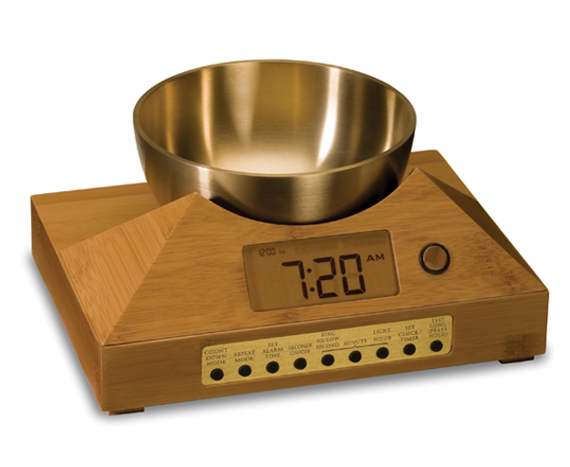 Bamboo Gong Meditation Timer and Alarm Clock Now & Zen, Inc.
1638 Pearl Street
Boulder, CO 80302
(800) 779-6383
Posted in Meditation Timers, Meditation Tools, mindfulness practice
 Sleep Getting enough shut-eye doesn’t just boost your energy — it may increase brainpower as well. Research shows that a good night’s sleep helps improve memory. In one recent study published in Nature Neuroscience, researchers found that sufficient sleep is also necessary to help retain episodic memory — your ability to remember times, places, and events. Although sleep needs vary, most of us require about eight hours a night.
Waking up in the morning should be as pleasant as falling asleep at night. The Zen Alarm Clock’s gradual, gentle awakening is transformative.
The Digital Zen Clock’s long-resonating Tibetan bell-like chime makes waking up a beautiful experience – its progressive chimes begin your day with grace.
adapted from Body + Soul Magazine, 2010
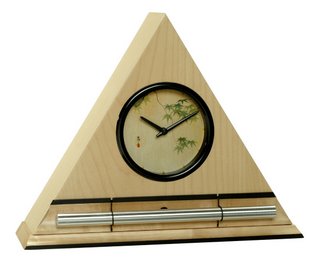 Japanese Maple Leaves Dial Face, the Zen Alarm Clock and Timer
Now & Zen – The Zen Alarm Clock Shop
1638 Pearl Street
Boulder, CO 80302
(800) 779-6383
Posted in Chime Alarm Clocks, sleep, Sleep Habits
 Instant Calm You’re cut off while driving. Your children erupt into a screaming fight. Or you’re five minutes away from an interview for the job of your dreams and your composure evaporates in a rush of anxiety. When life delivers adversity, stress is the common response. Your body kicks into action, preparing for a fight. The adrenal glands pump out adrenaline and noradrenaline — hormones that increase the heart rate, quicken breathing, raise blood pressure, and tense muscles. You’re ready to take on the perceived threat to your safety or well-being.
Of course, in reality we rarely run from foes or physically challenge them. As a result, we don’t burn off these powerful hormones, leaving them to “course through our bloodstream,” explains Dr. Herbert Benson, a pioneer in stress research at Harvard Medical School’s Mind/Body Medical Institute. In the short term, a pounding heart and sweaty palms can exacerbate the stressful emotions you’re already feeling. Left unchecked, this chemical mix sets you up for an array of physical and emotional problems, says Benson, including anxiety, depression, and intensified PMS and menopause symptoms.
The next time you are facing a stressful situation, stop yourself from spiraling out of control and bring yourself back to center.
Here is one exercise:
During a stressful event, your thoughts can intensify the storm inside of you. For example, say you’re about to give an important presentation to a large audience. You might find yourself worrying that you’ll get the facts wrong. This kind of worst-case-scenario thinking can increase the rush of stress hormones, worsening your prespeech jitters.
A technique known as “thought-stopping” can help you halt these negative, obsessive thoughts, says Dr. Kenneth Ruggiero, assistant professor in the department of psychiatry and behavioral sciences at the Medical University of South Carolina in Charleston. The first step, he says, is to literally call a halt to this train of thought. If you’re alone, say the word “Stop!” out loud. If you’re around others, think it to yourself. Some people even find it useful to pinch themselves to disrupt those stressful thoughts, says Ruggiero. “This gives you a moment of distraction,” he says, “and an opportunity to change your focus.”
Next, choose a positive thought on which you’ll focus instead, such as “I’ve given presentations before, and they went well” or “I know this material better than anyone in the audience.” In doing so, says Ruggiero, you swap a negative, stress-inducing thought for a positive one.
adapted from Body + Soul Magazine, 2010 by Erin O’Donnell
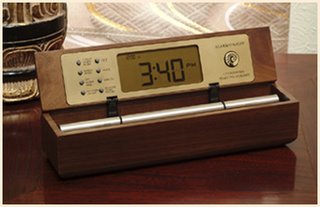 Walnut Wood Meditation Timers with Chime Now & Zen – The Zen Alarm Clock Store Headquarters
1638 Pearl Street
Boulder, CO 80302
(800) 779-6383
Posted in intention, mindfulness practice, Well-being
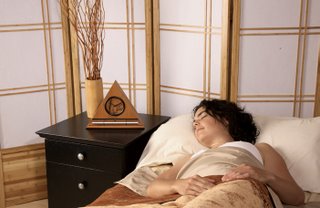 Soothing Bedroom Tips Prepare your bedroom for a good night’s sleep by reducing incoming light, lowering the temperature and removing any clutter from around your bed.
Trouble sleeping? Feeling tired? Check these bedroom trouble spots.
Light
If you can see your hand after the lights are turned off, your bedroom is too light. Streetlights, nightlights and appliances can produce enough light to disrupt the production of melatonin, the hormone that helps regulate the sleep cycle, causing effects similar to jet lag.
■ Fix It: Move or cover light sources. If streetlights invade your bedroom, install lightblocking drapes. Also limit light exposure before bedtime. Being surrounded by electric light in the evening—even checking e-mail before bed—can reset your biological clock and make falling asleep difficult.
Temperature
Heating the bedroom in cold weather isn’t just a waste of energy; it also messes with your sleep.
■ Fix It: A temperature of 65 degrees is ideal for sleep. Keep warm with a comforter or blankets that retain body heat.
Noise
Sudden loud noises can awaken you, and even passing traffic can fragment sleep.
■ Fix It: Sleep as far as possible from the street and noisy appliances. Mask other sounds with earplugs, a “white noise” generator or a fan.
Visual Noise
Clutter, visual distractions, stimulating colors, bright lights and TV can all distract sleepers.
■ Fix It: Paint your walls soothing colors such as lavender, blue or light green, and remove everything nonessential from your nightstand.
Shui that Feng
If you’re not sleeping well, check the position of your bed, which may be a source of distress. Consider rearranging if your bed is:
■ Over the garage or entry.
■ Near a fuse box or other electrical source.
■ Aligned with doorways.
adapted from Natural Home Magazine, Nov/Dec 2010 by Carol Venolia
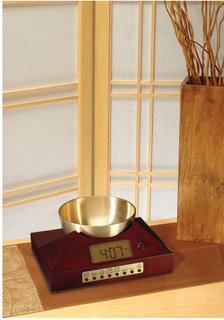 Zen Timepiece in Cherry Finish with Tibetan Bowl Alarm Clock Now & Zen’ Alarm Clock Store
1638 Pearl Street
Boulder, CO 80302
(800) 779-6383
Posted in Feng Shui
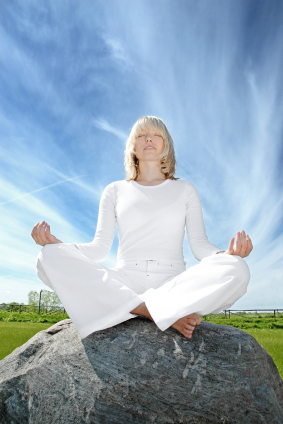 meditation mindfulness It may start in your head, but it’s often your body that bears the brunt of chronic stress. A likely risk factor for heart disease and cancer — the two leading causes of death in the United States — chronic stress has also been linked to insomnia, migraines, lowered immunity, increased abdominal fat, and digestive problems.
Although it might not seem as dire a problem as smoking or a decades-long fast-food habit, chronic stress may be every bit as damaging. Scientists aren’t clear how it contributes to illness, but there are likely both behavioral and physiological factors at work. When you’re under stress, you’re less likely to eat well or exercise, but evidence also suggests that the release of stress hormones could promote low-level inflammation (an effect that may, in turn, contribute to a host of ailments and chronic illnesses).
Reducing stress, then, is an absolute must for good health. But rather than rely on the annual vacation to melt away tension, build in daily prevention. “Our bodies and minds are shrieking for us to take better care of ourselves,” says Alice Domar, Ph.D., founder of the Domar Center for Mind/Body Health in Waltham, Massachusetts.
One Solution: Meditation
Meditation
Everybody needs a sanctuary, a place to rest and renew. The beauty of meditation — a proven and profound form of self-care for mind and body — is that almost anytime, anywhere, you can access that place of restorative calm.
Yet for some, meditation sounds mysterious or intimidating, probably because of some common misconceptions: that it’s dry or boring or “too spiritual”; that it’s an esoteric practice for those operating on some higher, more rarefied plane.
Yes, meditation is an ancient spiritual practice — one that cuts across different religions and many different traditions. But what it boils down to — however it’s practiced and whatever form it takes — is this: To meditate simply means to rest in moments of appreciative, exquisite attentiveness. Moments that allow us to savor the experience of living and that make us feel both deeply calm and deeply alert, in tune both with our self and with the world around us. Moments we come away from feeling refreshed, renewed, and engaged. Meditation is a way of communing with spirit.
We all know how to meditate; it’s an instinctive ability. If you’ve ever been deliciously absorbed gazing at the flow of a river, the dance of a fire, or the twinkle of stars, you’ve enjoyed meditative moments. And you can create those moments almost anywhere at any time. If you have a favorite place in your home in which to meditate, that’s wonderful. But you can meditate just as effectively sitting at your desk or on a park bench, or lying in the grass. The fact is, the juicier and more sensual you let meditation be, the more you will get out of it.
Meditating on a daily basis is easy. Give yourself a space of time — 10 to 20 minutes morning and afternoon, or if that’s not possible, a few minutes here and there throughout the day. Choose a pleasing, peaceful focus for attention — sensations, such as the flow of your breath; a sound you make, such as ahhh; or a visual image, such as waves coming to shore. This is your home base. Lightly focus your attention, and when your mind wanders off, gently come back to home base. Minds wander — a lot. So go easy on yourself and accept the process. Set your Meditation Chime Timer (Now & Zen, $199.95) for 20 minutes. When you hear the gentle chime, slowly open your eyes.
Our Meditation Chime Clock’s long-resonating Tibetan bell-like chime makes waking up and meditating a beautiful experience – its progressive chimes begin your day with grace.
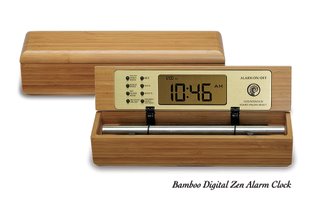 Meditation Chime Timer by Now & Zen, Inc. - Boulder, CO Those are the basics, but there is no one right way to meditate; explore what works for you. These two simple meditations will help you get started.
Meditation One: Sensuousness of Breath
Time: 5 to 10 minutes.
When and Where: Anytime, anywhere.
Position: Sitting comfortably or lying down, eyes open or closed.
Intention: I bask in healing pleasure. I receive the nourishment into every cell of my body.
One of the most universal meditation practices is to take pleasure in the flow and rhythm of breath. Buddha described this as “breathing in and out sensitive to rapture.”
1. Breathe out with a deep sigh a few times and notice what that feels like. Let yourself make quiet whooshing sounds. If you feel a stretch or a yawn coming on, give in to it. Gently ask yourself, “What pleasure do I feel in breathing?”
2. Explore the sensations that accompany breathing — the feeling of the chest expanding and contracting, the gentle touch of the air gliding through the nose and down the throat, filling and then emptying the lungs. How luscious can you let breathing be? Perhaps you enjoy the relaxing ebb and flow of the breath, or love breathing’s whispering sounds. If you’re outside, you might savor the fragrance of grass, trees, or flowers as you inhale. You might feel simple wonder at receiving this essential gift from life.
3. Breathe with this type of awareness for 10 minutes or so, allowing your attention to be soft and undemanding, like rose petals on your skin. Thoughts and feelings about your life will come into your awareness; this is healthy and healing, so don’t try to block them out. Just keep coming back, gently, to the sensuousness of breath when you can.
 Singing Bowl Meditation Timer by Now & Zen, Inc. Meditation Two: Heart Warming
Time: 5 to 20 minutes.
When and Where: Anytime, although the end of the day is nice. Try to find a cozy place.
Position: Sitting comfortably or lying down, eyes open or closed.
Intention: I am awake to love. I am ready to give and receive.
In this meditation you give yourself time to feel the emotional impact of all that is in your heart. Be leisurely, and linger in any of the meditation’s phases for as long as you like.
1. Begin by thinking of someone or something you love without reservation. Notice the sensations that arise in your heart and let yourself be with whatever is there — warmth, aching, joy, longing.
2. Bring both hands to your heart, feeling the warm contact of your palms against your chest. Imagine your heart being warmed by your love, melting any cold places, any part of you that is afraid, grieving, or lonely.
3. Make a humming sound, such as ahhh or ohhmm. Enjoy the way the sound vibrates in your chest for as long as you like. Then gradually let the sound fade away; you can return to it at any time.
4. Again notice the contact of your hands on your heart. Slowly open your arms outward, as you would to embrace someone. Take a few breaths and then slowly bring your hands back to your chest. Repeat this movement several times with great leisure. The simple motion of opening to give and drawing in to receive is a yoga of the heart, a way of expressing balance. End by bringing your hands back to your heart; pause, savoring the sensations and feelings.
Benefits of Meditation
– Promotes relaxation
– Enhances health
– Cultivates vitality
– Fosters clarity
– Increases focus
– Reduces stress
adapted from Body + Soul, April 2008 & June 2005 by Lorin Roche
 Chime Wake Up Clock by Now & Zen
Now & Zen’s Meditation Chime Timer Store
1638 Pearl Street
Boulder, CO 80302
(800 779-6383
Posted in intention
 How to Create Instant Calm A healing art based in traditional Chinese medicine, acupressure involves pressing specific points on your body to release muscle tension and stimulate circulation and the flow of qi, or life energy. Two points on the back of your neck known as the “gates of the mind” can ease stress and clear your mind, says Dr. Michael Reed Gach, founder of the Acupressure Institute in Berkeley, California, and producer of the guided self-care DVD “Acupressure for Stress Relief.” As an added bonus, he adds, pressing these points can stop headaches from developing.
Tilt your head back and place your thumbs at the top of your neck, just below the base of your skull, about three inches apart. Press these spots firmly but gently. “You don’t want to press on the skull, but just underneath it,” Gach says. “If your thumbs are weak or arthritic, use your knuckles instead.” As you press, take three to five slow, deep breaths. Finish by letting your hands float into your lap and your chin drop to your chest. Take an additional deep breath, and briefly scan your body to see how you feel. You can repeat this three times, set your Zen Chime Timer so that it repeats every ten seconds so that you can time your breathing.
adapted from Body + Soul July/August 2006
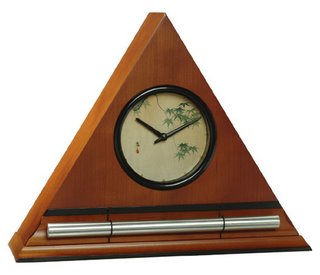 wake up alarm clocks with chimes Now & Zen’s Chime Meditation Timer Store
1638 Pearl Street
Boulder, CO 80302
(800) 779-6383
Posted in intention, mindfulness practice, Now & Zen Alarm Clocks, wake up alarm clock, Well-being
|
|
|
|